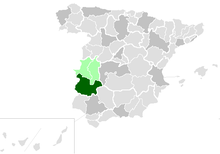Bishop of Badajoz
|
Archdiocese of Mérida-Badajoz Archidioecesis Emeritensis Augustanus-Pacensis Archidiócesis de Mérida-Badajoz |
|
|---|---|

|
|
| Location | |
| Country | Spain |
| Ecclesiastical province | Mérida-Badajoz |
| Statistics | |
| Area | 17,405 km2 (6,720 sq mi) |
| Population - Total - Catholics |
(as of 2004) 585,290 581,414 (99.3%) |
| Information | |
| Denomination | Roman Catholic |
| Sui iuris church | Latin Church |
| Rite | Roman Rite |
| Established | 1255 (As Diocese of Badajoz) 28 July 1994 (As Archdiocese of Mérida-Badajoz) |
| Cathedral | Cathedral of St John the Baptist in Badajoz |
| Co-cathedral | Co-Cathedral of Saint Mary Major, Mérida |
| Current leadership | |
| Pope | Francis |
| Metropolitan Archbishop | Celso Morga Iruzubieta (formerly, Coadjutor Archbishop until Thursday, May 21, 2015) |
| Suffragans |
Diocese of Coria-Cáceres Diocese of Plasencia |
| Emeritus Bishops | Santiago García Aracil Archbishop Emeritus (retired in 2015) Antonio Montero Moreno Archbishop Emeritus (1994-2004) |
| Map | |
 |
|
| Website | |
| Website of the Archdiocese | |
The diocese of Badajoz was a Roman Catholic ecclesiastical territory in Spain, created in 1255. In 1994 it became the Archdiocese of Mérida-Badajoz.
The Diocese or Archdiocese of Mérida (dioecesis Emeritensis) was a Catholic and Arian see centred on the Spanish city of Mérida during the periods of Roman and Visigothic rule. Mérida was also the provincial capital of Lusitania.
The see prospered in the late 5th century under Zeno, a Greek, who was offered greater authority in order to defend the province from Suevic raids. At about that time the diocese fell under the control of the Visigoths and it remained a Visigothic see until the Moorish conquest of 711. Throughout that period, however, it only ever had two Gothic bishops: Masona and his successor Renovatus in the late sixth and early seventh centuries. In the mid-sixth century the see became the richest in Spain through the private wealth of bishops Paul and Fidelis, Greek uncle and nephew. Under these four, the city was ruled de facto by the bishops independent of the central government, a situation which led to conflict between the Arian king Leovigild and his bishop, Sunna.
The bishopric of Badajoz was erected in 1225, shortly after it was reconquered from the Moors by King Alfonso IX of León. Its first bishop was Don Pedro Perez, appointed by Alfonso X, the Wise. The diocese was suffragan to the archdiocese of Seville, and was bounded on the north by the diocese of Coria, diocese of Plasencia, and diocese of Toledo, on the east by Toledo, the diocese of Ciudad Real, and the diocese of Córdoba, on the south by the archdiocese of Seville, and on the west by Portugal.
...
Wikipedia
